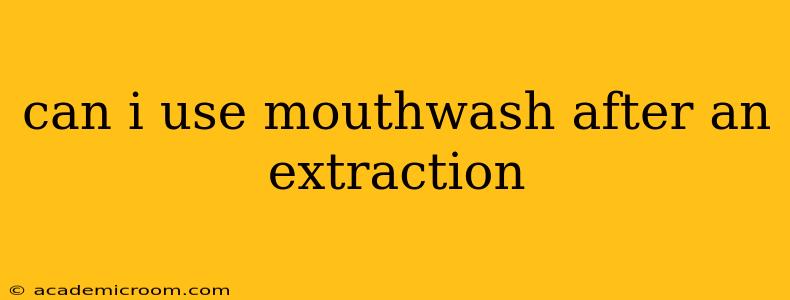Following a tooth extraction, maintaining impeccable oral hygiene is crucial for preventing infection and promoting proper healing. Many wonder if mouthwash can be part of this post-extraction care routine. The short answer is: it depends. Using mouthwash after an extraction requires careful consideration and timing. This guide will explore the nuances of mouthwash use post-extraction, addressing common concerns and providing expert advice.
What Kind of Mouthwash Should I Use After a Tooth Extraction?
This is a key question, and the answer is generally not the strong, alcohol-based mouthwashes you might typically use. Alcohol can irritate the extraction site, slowing down healing and potentially causing pain. Instead, your dentist may recommend a gentle, alcohol-free mouthwash, perhaps one with chlorhexidine or another antiseptic agent to help control bacteria. Always follow your dentist's specific instructions. Using the wrong type of mouthwash could hinder the healing process.
When Can I Start Using Mouthwash After a Tooth Extraction?
Rinsing your mouth too soon after extraction can dislodge the blood clot forming in the socket, leading to a painful and potentially serious complication called dry socket. Generally, you should wait at least 24 hours before using any mouthwash. Even then, start gently and avoid forceful rinsing or spitting.
How long should I wait before using mouthwash after a tooth extraction?
As mentioned, waiting at least 24 hours is recommended. However, the best timeframe will depend on the specific circumstances of your extraction and your dentist’s instructions. Some dentists might suggest waiting even longer, particularly if the extraction was complex. Always prioritize your dentist's guidance.
What are the Risks of Using Mouthwash After a Tooth Extraction?
While a gentle mouthwash can be beneficial, there are potential risks:
- Dry Socket: The most significant risk is dislodging the blood clot, leading to dry socket (alveolar osteitis). This is extremely painful and requires professional dental intervention.
- Irritation: Some mouthwashes, particularly those containing alcohol, can irritate the sensitive extraction site, delaying healing and increasing discomfort.
- Interaction with Medications: Certain mouthwashes might interact negatively with medications you're taking for pain or infection.
What's the Best Way to Rinse My Mouth After an Extraction?
If your dentist approves mouthwash use, follow these gentle techniques:
- Use a small amount: Don't overdo it; a small amount of mouthwash is sufficient.
- Gentle swishing: Avoid vigorous swishing or spitting, which could dislodge the blood clot.
- Avoid direct contact: Try to avoid directing the flow of mouthwash directly onto the extraction site.
Are there Alternatives to Mouthwash for Oral Hygiene After Extraction?
Yes! Even before you can use mouthwash, maintaining good oral hygiene is vital. Focus on:
- Gentle brushing: Brush your teeth gently, avoiding the extraction site.
- Saltwater rinses: A warm saltwater rinse (1/2 teaspoon salt in 8 ounces of warm water) is a gentle and effective way to clean your mouth and help prevent infection, especially in the initial 24-48 hours.
Should I Use Mouthwash if I Have Dry Socket?
No. If you suspect you have dry socket (intense pain, bad odor, exposed bone), contact your dentist immediately. Using mouthwash could worsen the situation.
In conclusion, using mouthwash after an extraction should be done with caution and under the guidance of your dentist. Prioritize gentle oral hygiene, wait the recommended time, and choose an alcohol-free mouthwash if approved. Remember that proper post-extraction care is crucial for optimal healing and minimizing discomfort. Always consult your dentist with any concerns or questions you may have.
